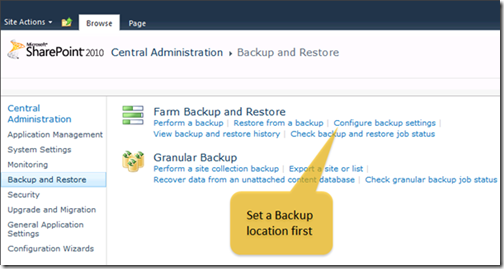Backup/Restore for SharePoint 2010
This is an overview of major tools and techniques available to backup/restore your SharePoint 2010 farm
Using DPM to Backup/Restore SharePoint 2010
Microsoft System Center Data Protection Manager 2010 (DPM) is a product designed to manage ongoing, comprehensive backups of Microsoft enterprise products, including SharePoint 2010.
- Protect at farm level – recover and track at granular level.
- Automatic discovery & protection of new databases.
- Seamlessly supports all SQL high-availability solutions.
- Easy to configure and manage short-term and long-term backups
- Optimized for large farms.
- Faster backups than SharePoint-only backup solutions.
- Requires significantly less storage than SQL-only backup solutions.
- Search for SharePoint item through all recovery points of the farm.
- Retains metadata/security settings for the recovered item.
- Granular recovery without a recovery farm for SharePoint 2010.
More information on DPM: https://technet.microsoft.com/en-us/systemcenter/dm.
Backup/Restore for SharePoint using its own tools
SharePoint provides many of its own tools for backup and restore. This section discusses these options.
The Central Administration Backup and Restore page organizes SharePoint’s monitoring tools:
Central Administration provides tools for performing individual backups of the entire farm, individual site collections, sites, libraries or lists. A full farm backup can be restored from Central Administration, but tools are not provided here for scheduling recurring backups, or for restoring individual site collections, site, libraries or lists. These operations can be managed using PowerShell scripts:
Cmdlet |
Synopsis |
Backup-SPFarm (Restore-SPFarm) |
Creates a backup of an individual database, Web application, or the entire farm. Can be full or differential. Use Backup-SPFarm -ShowTree to display a list of what would be backed up; this does not perform the backup. |
Backup-SPSite (Restore-SPSite) |
Performs a backup of a site collection. |
Backup-SPConfigurationDatabase (Restore-SPFarm) |
Performs a farm-level configuration-only backup. This is not a typical backup operation, see Note* below. |
To schedule automated recurring backups, use these PowerShell cmdlets in scripts that are scheduled with the Windows Task Scheduler. This recommendation is from the TechNet article Backup and recovery overview (SharePoint Server 2010).
*Note that Central admin gives an option for backing up the config database, but you normally never restore the config database, even when restoring the farm. In DR scenarios, you create a new farm and restore the site collection DBs. An example use for a configuration database backup is to create a farm configuration template that can then be applied to create other new SharePoint farms that have identical physical topologies, by using Restore-SPFarm. This could be very useful in hosting scenarios with baseline virtual images.
SQL backup tools will process the data faster. DPM will process even faster and repeated backups require much less space.
So if you're planning daily backups of 500 GB, CA farm backup may be too slow. SQL backup will get it faster but require 2.5 TB to store 5 backups. DPM will be fastest and probably require less than 1 TB for 5 backups of 500 GB (depending on content churn).
